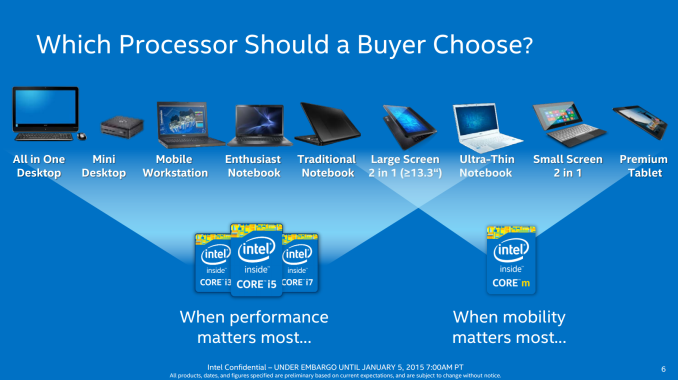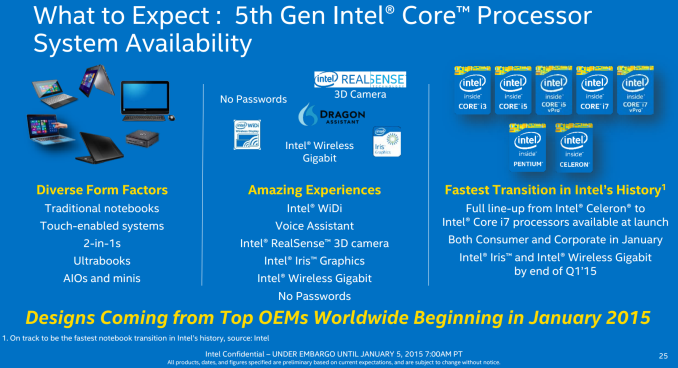Intel Releases Broadwell-U: New SKUs, up to 48 EUs and Iris 6100
by Ian Cutress on January 5, 2015 10:00 AM ESTFitting in With Core M
The staggered release of Broadwell is nothing new. Previous releases from Intel has seen them pick a particular market and aim at that first, whether it be tablet, mobile devices, ultrabooks or desktops, with the rest to follow. Core M, Intel’s 4.5 W ‘Broadwell-Y’ part, has been in the market for over a month with designs such as the Lenovo Yoga 3 Pro, although the number of SKUs available as well as worldwide distribution has been relatively slow, with the designs featuring Core M being expensive in terms of casual computing and more premium upgrades. Broadwell-U changes this by opening up the power envelope, and as such Intel sees the market at follows:
The Broadwell-U processors from Intel are aiming to give enough performance from AIO desktop systems to mini desktops, premium mobile applications all through to large 2-in-1s. There is some overlap with Core M, particularly with the 7.5W cTDP down elements of the range, but the interesting element will be pricing. The Celerons come in around $100, with the Pentium at $160, but then it gets expensive for Broadwell-U. $275 to $315 covers all the i3 and i5 parts both at 15W and 28W, ending with $393/$426 for the i7 parts. Further to my efficiency comments above, on paper at least the i5-5350U or i5-5250U would seem the most interesting processors of the bunch.
Release Dates
In our conference call with Intel, it was clear that these CPUs are shipping to their partners today. Throughout CES there will be a number of manufacturers announcing their products, and as per the norm Intel allows the partners to introduce their own products, rather than showing examples of where Broadwell-U fits in. However, because Broadwell-U is designed to be pin-compatible with Haswell-U, we might see some manufacturers purely re-releasing some of their designs with the newer CPU and a firmware update. Nevertheless, Intel is expecting OEM systems with Broadwell-U to start shipping in North America within the month. Designs with Iris graphics, or those featuring Intel based WiGig connectivity, will be more towards the end of Q1. Overall Intel is tracking ‘hundreds of designs’ involving Broadwell, indicating that it will be a significant push to bring 14nm to the market.












85 Comments
View All Comments
Drumsticks - Monday, January 5, 2015 - link
Thanks. I hope we see the power improvements here coupled with the same or larger batteries (maybe with the extra space...) i am really hoping the Surface Pro 4 can consistently break ten hours (which is the "great enough" spot for me) per charge, which would make me happily drop my SP1.fallaha56 - Monday, January 5, 2015 - link
then let's hope for a Skylake Surface 4 -too little change hereWalkop - Monday, January 5, 2015 - link
Brianandforce? ;)Agreed here definitely. I'd really like a Skylake SP4, we'd see some serious jumps there. It deserves Skylake anyway, we've skipped a generation of performance improvement.
ws3 - Monday, January 5, 2015 - link
I was right with you until the last phrase. You need a 10-hour Surface Pro 4 in order to drop your 4-hour Surface Pro 1, when both the Surface Pro 2 & Surface Pro 3 already offer significantly improved battery life?Aftershocker - Friday, January 9, 2015 - link
Love my SP 2. Skipped the SP3 because my SP2 was only a couple of months old and because of the throttling issues. I do hope they do a SP3 refresh with these chips though, ahead of a full Skylake SP4. I'm assuming they would likely go for the 5500HD parts because of the lower cTDP requirement?aegisofrime - Monday, January 5, 2015 - link
Any word on desktop parts?TiGr1982 - Monday, January 5, 2015 - link
According to last year rumors, desktop parts are supposed to happen as Broadwell-K Core i5 and i7 for LGA1150 (for 90-series chipsets M/B only) around Q3 2015 (Q2 2015 at best).kspirit - Monday, January 5, 2015 - link
It's articles like this that make me keep coming back to this website. Thanks a lot for the info. I hope we get to see some direct benchmarks against Haswell, especially in the battery life area. 5% IPC improvement isn't too big, but then again it is just a die shrink and we shouldn't expect too much more. I am much more interested in battery life, since now Intel and MS seem to be really collaborating on that end since W8 was launched.I'm not holding my breath on some big battery improvements though. Excellent battery life with Haswell was already possible, but except for some OEMs (like Samsung with Ativ Book 9 and ASUS with Zenbooks), none put in the effort to really make the most of it.
Nice article. *thumbs up*
Galatian - Monday, January 5, 2015 - link
We really have to wait for benchmarks. Right now it feel too much like "meh" to me. TDP stayed the same. Sure there are some performance increases especially on the GPU side, but I would say they mostly come from more transistors. I was hoping that 14 nm would bring them more energy saving.And the elephant in the room is still Skylake. I have both a 13" rMBP on Ivy and a Surface Pro 2 on Haswell, which both could use a upgrade (the MacBook more on the CPU side and the Surface more on the GPU side in my use cases). I was hoping for Quad Cores in the 28 W range on 14 nm, so a 13" rMBP could go all Quad. Also weren't there plans for a complete overhaul off the GPU architecture? Is that now scheduled for Skylake?
kspirit - Monday, January 5, 2015 - link
Does Intel update architecture at all in the year of the die shrink? That's news to me, I didn't know any GPU rework was planned. :o